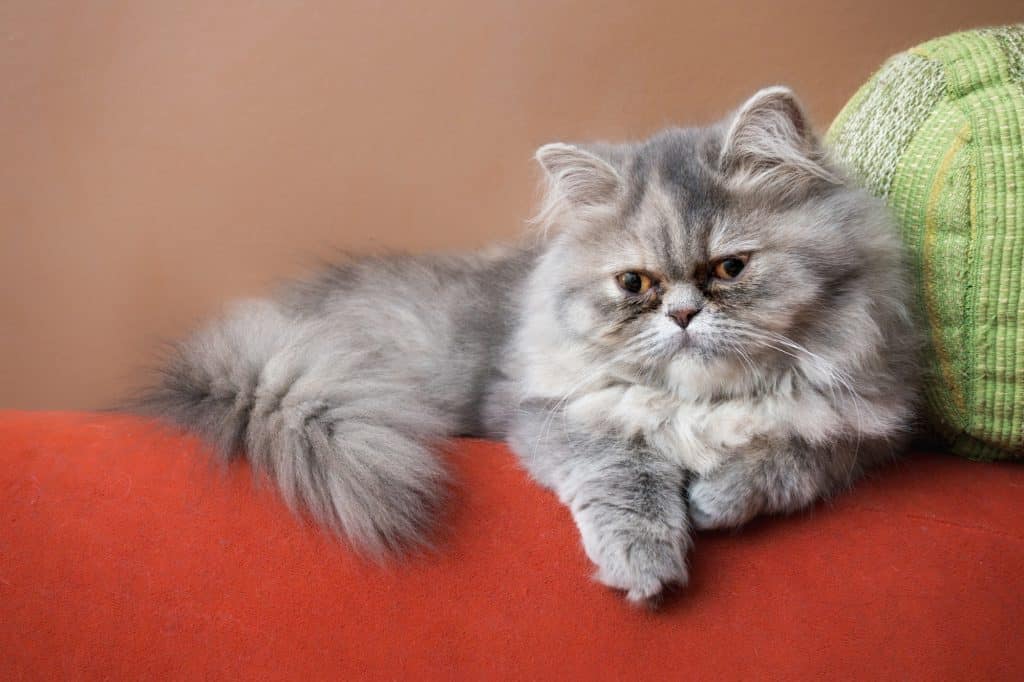If you fell in love with Crookshanks – Hermione’s ginger beauty in Harry Potter – while being partial to big blue eyes, it would be quite the task to choose between the noble Persian and the lustrous Ragdoll.
This article will discuss the differences between the two breeds to help you make an informed decision.
Ragdoll vs. Persian
The difference in the two breeds’ temperament is the leading deciding factor of the Ragdoll vs. Persian conundrum. The Ragdoll is commonly denoted as portraying “dog-like” behavior, while the Persian cat might very well be the embodiment of the tale that cats keep their humans as servants.
Since both breeds have their perks, the only way to decide on which feline will be best suited to join your family is to delve a little deeper into the distinctiveness of the individual breeds.
To do that, we’ll be comparing factors such as temperament, appearance, and general requirements to find the best match for you.
Ragdoll vs. Persian: A Brief History
Ragdoll
A relatively new breed of about 60 years, the Ragdoll dug its roots in 1960s California. Ann Baker is the creator of this blue-eyed beauty, and it is believed that the Ragdoll was born from two longhaired cats.
However, there is plenty of vagueness around the exact bloodline of the Ragdoll’s lineage. Selective breeding – to crossbreed for more desirable features – was not as well documented as it is today (as will be evident in the Persian’s history as well).
Persian
The elegant breed has been around a tad longer than the Ragdoll. Still, the Persian has a long and somewhat muddled history involving longhaired cats from Italy and Turkey.
Queen Victoria was fond of the felines, and with her affection, the breed gained esteem among other Royals. In the USA, Persian cats became quite the rage after the 19th century.
But with some of the health issues accompanying their flat faces, their popularity began to decline.
Ragdoll vs. Persian: A Complete Comparison
Size
Ragdoll females can reach 8 to 15 lbs. and males 12 to 20 lbs.
Persians are not as big as Ragdolls but still come in at an impressive size; females are between 6 and 11 lbs. and males up to 12 lbs.
Lifespan
Ragdolls typically live between 7 to 12 years, and Persians are not too far behind by 8 to 11 years. Of course, these are only estimates.
Depending on factors such as diet, environment, and health, these cats can push it well beyond 12 years.
Recognition
Ragdolls and Persians are both recognized by the Cat Fanciers’ Association (CFA), the American Cat Fanciers’ Association (ACFA), the Fédération Internationale Féline (FIFe), and The International Cat Association (TICA).
Appearance
Ragdolls have big, beautiful blue eyes, silky coats that can be long or semi-long. Most kittens are born white and develop their coloring when they are two weeks old.
Patterns vary between bicolor, points (light coat with darker face, ears, tail, and paws), and mitted (bright white paws). They come in all sorts of fascinating colors: lilac, seal, red, cream, blue-cream, frost, blue, and chocolate.
The stand-out feature of the Persians is their round, flat faces. Eye color can range between blue, green, and hazel and sometimes even odd-eyes (one blue and one hazel, for example).

They have long silky coats with exquisite patterns such as tortoiseshell, bicolor, calico, tabby, smoke, shades, points, and solid colors.
They are available in the basic white, red, cream, black, brown, and blue, with more exotic tones such as chocolate, lilac, golden, cameo, blue-cream, and seal.
Grooming
Because of the thickness and length of their coats, both breeds shed quite a lot of hair. Though this might sound a little daunting, it can be easily managed with daily brushing.
Not only will this keep their fur from matting, but it should decrease the amount of loose hair collecting in all the corners of your home.
Daily grooming is also essential for longhaired cats to avoid the terrible retching caused by hairballs.
Apart from a thorough brush every day, a Persian’s face, especially the eyes and nose, needs to be cleaned regularly to avoid tearstains and rheum buildup (eye gum). And because they have flat faces, eating can be a bit of a messy business when you feed wet food.
More than likely, you’ll need to give their faces a gentle wipe after they enjoyed a meal: you can also lessen the mess by providing a wide, shallow dish for your Persian cat.
Health
Generally, most felines are prone to health issues such as dental issues, skin problems, gastrointestinal upsets, and weight problems. Therefore, nutrition should be carefully controlled to avoid weight problems.
Nutrition control is not breed-specific; this means that regardless of breed, you have to feed your cat a healthy diet according to their weight and activity level.
Persians and Ragdolls have hereditary health issues you should keep an eye out for. These include polycystic kidney disease and hypertrophic cardiomyopathy.
In addition, the Persian is also prone to progressive renal atrophy, bladder stones, cystitis, and liver shunts.
Cost
Ragdoll kittens range from $800 to $2,000, and Persians can cost anything from $500 to $5,000. The variation in cost is mainly due to linage and high-end breeders.
While you might pay a little more for your kitten from a reputable breeder, at least you’ll know what you are paying for.
Space and Exercise Requirements
Both cats are suitable for apartment living; however, they will need exercise to keep in top form. While it might be a little challenging to teach your Persian to walk on a leash, you might succeed in getting your Ragdoll to go on walks.
However, there are various ways to exercise your Persian or Ragdoll in small spaces. You can provide interactive toys, play mice filled with catnip, cat trees/tunnels to clamber around, and of course, invest in a laser pointer.
Trainability
Ragdolls will be easier to train; unfortunately, the Persian is known for being a slow learner and not known to train well.
However, this does not mean your precious Persian will be doing potty all over the house.
Your kitten should be potty trained before you get them – their mothers teach them this valuable skill while she takes care of them.
Behavior
Both breeds are known to be placid, affectionate, and even-tempered. They enjoy being next to you or on top of your lap – depending on individual personalities.
As with any cat, they will have bursts of energy and go completely nuts for a couple of minutes as they expel energy.
However, the Ragdoll might retain kitten-like behavior until three years of age, while the Persian matures a little quicker into a calm cat that enjoys many naps.
Ragdoll vs. Persian: A Chart of the Main Differences
| Factor | Ragdoll | Persian |
|---|---|---|
| Size | Can reach up to 20 lbs. | Average on 12 lbs. |
| Appearance | Big blue eyes, medium to long silky fur, varied coat patterns, and colors | Flat face, long fluffy fur, varied coat patterns, and colors |
| Temperament | Dog-like behavior, affectionate, playful, gentle giants | Placid, friendly, affectionate, and a tendency to be lazy |
| Health | polycystic kidney disease hypertrophic cardiomyopathy | polycystic kidney disease, hypertrophic cardiomyopathy, progressive renal atrophy, |
| bladder stones, | ||
| cystitis, | ||
| liver shunts | ||
| Intelligence | Sharp-witted | Slow learner |
| Cost | Moderate to expensive | Expensive to very expensive |
Ragdoll vs. Persian: Which Breed is Right for You?
Ragdoll
This breed might be the perfect cat to join your home if you want a playful kitty. Some owners have reported that Ragdolls exhibit dog-like behavior, playing fetch, chasing balls, making them perfect family pets.
The Ragdoll received its name from their supposed tendency to go limp when picked up; however, this might not be true for all Ragdolls.
Persian
If you are looking for a cat that suits a quiet lifestyle, Persian cats will be the best for you. While they are not unfriendly towards children, they might not tolerate constant disturbances.
If you decide to welcome this elegant feline into your home, have a conversation with your veterinarian about the hereditary health concerns your Persian might face and how to best avoid it.
Conclusion
Choosing between a Ragdoll and a Persian will boil down to your lifestyle and which temperament is best suited to it. Ragdolls might be best suited with large households, while Persians might prefer a more tranquil environment.
If you still can’t decide, check out how the Ragdoll stacks up against the Birman and Himalayan as well.

